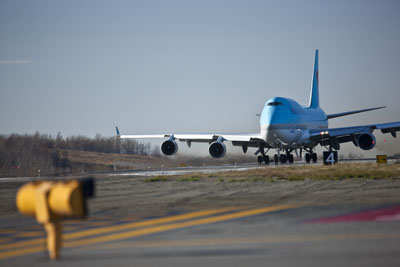Economic Impacts
The airport is an important contributor to Alaska’s economy and a critical link between Alaska communities, contiguous U.S., and international destinations.
- 1 in 10 Jobs in Anchorage directly or indirectly related to ANC
- $8 of every $10 are spent with Alaska’s private sector
- ANC is less than 9.5 hours from the industrialized world
- Always open for business, never a closure for weather
- Lake Hood Seaplane base is a gateway to Alaska tourism

Lake Hood Seaplane Base Economic Impact Study
In 2013, the Alaska Department of Transportation and Public Facilities’ Ted Stevens Anchorage International Airport (ANC) announced the completion of the Economic Impact Study for Lake Hood Seaplane Base (LHD). The report was commissioned in conjunction with the Anchorage Economic Development Corporation (AEDC) and was completed by the McDowell Group.
General aviation, particularly that generated from Lake Hood Seaplane Base, was at the heart of settlement and growth in remote areas of Alaska, and is part of the proud roots of the state’s aviation history. The economic impact study defines the current economic importance of the beloved landmark and helps identify how relevant the airport is for Alaskans.
Key findings in the study are:
- LHD has a total economic impact of $42 million. The direct economic impact is $25 million, and indirect impact is $17 million.
- Including direct, indirect and induced employment, LHD accounts for an estimated 230 jobs in 2012. This translates into approximately $14 million in labor income in 2012.
- LHD supports additional economic activity with many businesses and communities that rely on flight service provided by air charter operators, including fishing, hunting and wildlife viewing lodges.
- The majority of the 23,000 non-resident Alaska visitors who purchased a flightseeing tour from May 2011 to April 2012 flew out of LHD.
- Resource development, including mining exploration in Southwest, Southeast and Interior Alaska; oil and gas production in Cook Inlet, and resource and infrastructure development supporting private sector and government environmental research programs, are supported out of LHD.
Lake Hood Seaplane Base consists of Lake Hood, Lake Spenard and an adjacent gravel airstrip. LHD is considered the busiest seaplane base in the world, with approximately 500 float plane slips, and 500 wheeled airplane tie-downs. When the lake freezes in the winter, over 100 ski equipped airplanes use the ice runway.
TSAIA Economic Impact Report
In 2012, the Anchorage Economic Development Corporation (AEDC), in conjunction with McDowell Group, completed an Economic Impact Study requested by Ted Stevens Anchorage International Airport (ANC). Some key findings in the study are:
- ANC contributes more than 9,000 jobs directly and almost 6500 indirect or induced jobs to the Municipality of Anchorage, earning $1 billion in income.
- $8 out of every $10 ANC spends on purchases from Alaska’s private sector goes to businesses in Anchorage.
- ANC infrastructure construction projects generated over 1,000 jobs and $54 million in earnings.
- Businesses located at ANC contribute at least $2.3 million in property taxes to the Municipality of Anchorage.
- ANC is self-supporting, providing $101.2 million in operating & investment revenues for the International Airport Revenue Fund.
- 71% of all Asia bound cargo from the U.S. and 82% of all U.S. bound cargo from Asia transit through ANC.
- Passenger flights make up over 50,000 landings at ANC, while cargo flights equal more than 86,000 landings.
CLICK HERE TO VIEW THE FULL STUDY [PDF]
VIEW THE QUICK FACTS SHEET [PDF]
